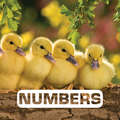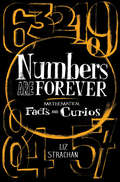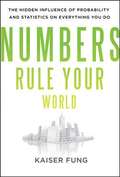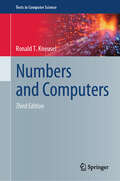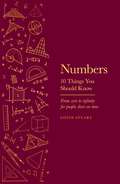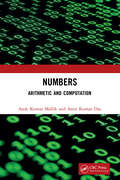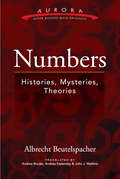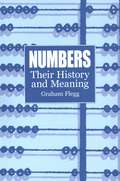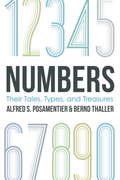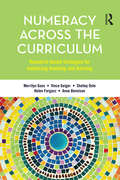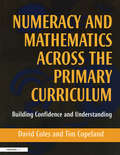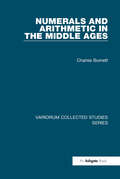- Table View
- List View
Numbers (Picture This)
by Judith NouvionNumbers are everywhere in nature. From one tiny red-eyed frog to ten sweet and scruffy dogs, children will practice counting to ten all while finding out some fun facts about animals in our natural world. Vibrant photography and simple, fun read-aloud text make this board book a perfect first look at nonfiction for very new and curious learners! The Picture This series pairs learning concepts with extraordinary photographs of animals in their habitats. Check out all four books in the Picture This series: Colors, Homes, Numbers, and Shapes!
Numbers Are Forever
by Liz StrachanThis book is only about numbers - that is, whole numbers and nothing but the whole numbers, which start from from 0, 1, 2, 3, 4... and go on forever. Here you can meet perfect numbers, happy numbers, lucky, untouchable, weird, narcissistic, evil and deficient numbers, not to mention nice Friedmans and multi-legged repunits, as well as primes and their cousins, the sexy primes. It is also full of fascinating facts and curios, prime number conjectures, the sieve of Eratosthenes, the Fibonacci series, and much more besides. This is an accessible, clearly explained approach which will appeal to recreational maths enthusiasts, puzzle solvers, and mathematicians of all ages.
Numbers Are Forever
by Liz StrachanThis book is only about numbers - that is, whole numbers and nothing but the whole numbers, which start from from 0, 1, 2, 3, 4... and go on forever. Here you can meet perfect numbers, happy numbers, lucky, untouchable, weird, narcissistic, evil and deficient numbers, not to mention nice Friedmans and multi-legged repunits, as well as primes and their cousins, the sexy primes. It is also full of fascinating facts and curios, prime number conjectures, the sieve of Eratosthenes, the Fibonacci series, and much more besides. This is an accessible, clearly explained approach which will appeal to recreational maths enthusiasts, puzzle solvers, and mathematicians of all ages.
Numbers Don't Lie: 71 Stories to Help Us Understand the Modern World
by Vaclav Smil"There is no author whose books I look forward to more than Vaclav Smil."--Bill GatesAn essential guide to understanding how numbers reveal the true state of our world--exploring a wide range of topics including energy, the environment, technology, transportation, and food production.Vaclav Smil's mission is to make facts matter. An environmental scientist, policy analyst, and a hugely prolific author, he is Bill Gates' go-to guy for making sense of our world. In Numbers Don't Lie, Smil answers questions such as: What's worse for the environment--your car or your phone? How much do the world's cows weigh (and what does it matter)? And what makes people happy? From data about our societies and populations, through measures of the fuels and foods that energize them, to the impact of transportation and inventions of our modern world--and how all of this affects the planet itself--in Numbers Don't Lie, Vaclav Smil takes us on a fact-finding adventure, using surprising statistics and illuminating graphs to challenge conventional thinking. Packed with fascinating information and memorable examples, Numbers Don't Lie reveals how the US is leading a rising worldwide trend in chicken consumption, that vaccination yields the best return on investment, and why electric cars aren't as great as we think (yet). Urgent and essential, with a mix of science, history, and wit--all in bite-sized chapters on a broad range of topics--Numbers Don't Lie inspires readers to interrogate what they take to be true.
Numbers Queen: A QUIX Book (Addy McBean #1)
by Margery CuylerA second-grade math whiz uses her beloved numbers to get herself out of trouble and ace a class project in this first book in the Addy McBean series—part of the Aladdin QUIX line!Addy McBean, a second grader at PS #8, is up to her eyebrows (two) in myriad (lots) adventures. She&’s never met a number she hasn&’t liked! When she&’s paired with Willard—a classmate who&’s not exactly her favorite—for a math project, Addy has to figure out a way to juggle Willard, numbers, and finishing the project!
Numbers Rule Your World: The Hidden Influence of Probability and Statistics on Everything You Do
by Kaiser FungThis fascinating book takes readers inside the hidden world of facts and figures that affect them every day.
Numbers Rule: The Vexing Mathematics of Democracy, from Plato to the Present
by George SzpiroA lively history of the peculiar math of votingSince the very birth of democracy in ancient Greece, the simple act of voting has given rise to mathematical paradoxes that have puzzled some of the greatest philosophers, statesmen, and mathematicians. Numbers Rule traces the epic quest by these thinkers to create a more perfect democracy and adapt to the ever-changing demands that each new generation places on our democratic institutions.In a sweeping narrative that combines history, biography, and mathematics, George Szpiro details the fascinating lives and big ideas of great minds such as Plato, Pliny the Younger, Ramon Llull, Pierre Simon Laplace, Thomas Jefferson, Alexander Hamilton, John von Neumann, and Kenneth Arrow, among many others. Each chapter in this riveting book tells the story of one or more of these visionaries and the problem they sought to overcome, like the Marquis de Condorcet, the eighteenth-century French nobleman who demonstrated that a majority vote in an election might not necessarily result in a clear winner. Szpiro takes readers from ancient Greece and Rome to medieval Europe, from the founding of the American republic and the French Revolution to today's high-stakes elective politics. He explains how mathematical paradoxes and enigmas can crop up in virtually any voting arena, from electing a class president, a pope, or prime minister to the apportionment of seats in Congress.Numbers Rule describes the trials and triumphs of the thinkers down through the ages who have dared the odds in pursuit of a just and equitable democracy.
Numbers and Computers
by Ronald T. KneuselThis is a book about numbers and how those numbers are represented in and operated on by computers. It is crucial that developers understand this area because the numerical operations allowed by computers, and the limitations of those operations, especially in the area of floating point math, affect virtually everything people try to do with computers. This book aims to fill this gap by exploring, in sufficient but not overwhelming detail, just what it is that computers do with numbers. Divided into two parts, the first deals with standard representations of integers and floating point numbers, while the second details several other number representations. Each chapter ends with exercises to review the key points. Topics covered include interval arithmetic, fixed-point numbers, floating point numbers, big integers and rational arithmetic. This book is for anyone who develops software including software engineerings, scientists, computer science students, engineering students and anyone who programs for fun.
Numbers and Computers
by Ronald T. KneuselThis is a book about numbers and how those numbers are represented in and operated on by computers. It is crucial that developers understand this area because the numerical operations allowed by computers, and the limitations of those operations, especially in the area of floating point math, affect virtually everything people try to do with computers. This book aims to fill this gap by exploring, in sufficient but not overwhelming detail, just what it is that computers do with numbers. Divided into two parts, the first deals with standard representations of integers and floating point numbers, while the second examines several other number representations. Details are explained thoroughly, with clarity and specificity. Each chapter ends with a summary, recommendations, carefully selected references, and exercises to review the key points. Topics covered include interval arithmetic, fixed-point numbers, big integers and rational arithmetic. This new edition has three new chapters: Pitfalls of Floating-Point Numbers (and How to Avoid Them), Arbitrary Precision Floating Point, and Other Number Systems. This book is for anyone who develops software including software engineers, scientists, computer science students, engineering students and anyone who programs for fun.
Numbers and Computers (Texts in Computer Science)
by Ronald T. KneuselThis textbook details the variety of number formats used by computers, thereby helping to ground readers in what can and cannot be represented accurately, especially by floating-point numbers. The book's first part details standard representations of integers and floating-point numbers. The second explores other number representations, including the wide variety recently developed to support artificial intelligence (AI) and its demand for efficiency in representation to accommodate the ever-expanding scope of neural network models. Chapters describe each format, with examples in code (Python and C) and exercises. This new edition includes three new chapters on posits, AI number formats, and a collaborative experiment with an AI to generate novel number formats. Topics and features: Explores how computers use numbers to complete operations Adds new chapters on posits and AI number formats Includes exercises and examples that are code snippets in C or Python Implements and tests new AI-designed number formats (as designed by GPT-4) Provides thorough grounding on what can and cannot be represented accurately A textbook eminently suitable for undergraduates in computer science, the work also will appeal to software developers, engineers, scientists, AI experts, and anyone who programs for fun.
Numbers and Functions
by R. P. BurnThe transition from studying calculus in schools to studying mathematical analysis at university is notoriously difficult. In this new edition of Numbers and Functions, Dr Burn invites the student reader to tackle each of the key concepts in turn, progressing from experience through a structured sequence of several hundred problems to concepts, definitions and proofs of classical real analysis. The sequence of problems, which all have solutions supplied, draws students into constructing definitions and theorems for themselves. This natural development is informed and complemented by historical insight. The novel approach to rigorous analysis offered here is designed to enable students to grow in confidence and skill and thus overcome the traditional difficulties.
Numbers and Other Math Ideas Come Alive
by Theoni PappasMost people don't think about numbers, or take them for granted. For the average person numbers are looked upon as cold, clinical, inanimate objects. Math ideas are viewed as something to get a job done or a problem solved. Get ready for a big surprise with Numbers and Other Math Ideas Come Alive. Pappas explores mathematical ideas by looking behind the scenes of what numbers, points, lines, and other concepts are saying and thinking. In each story, properties and characteristics of math ideas are entertainingly uncovered and explained through the dialogues and actions of its math characters. In fact, you forget that you are actually learning mathematics as you get caught up in the characters' private lives, secrets and how they interact with one another. You may even forget that these math actors come from the imaginary worlds of mathematics. They seem so real! This is the crux of Numbers and Other Math Ideas Come Alive -- number and math ideas tell their own stories in their own words. As you read these stories you will be amazed at how math ideas come to life and develop their own personalities. We learn about their foibles and strengths, and see why mathematicians had to develop new concepts when the old ones were not sufficient for the problems at hand. You'll see how mathematics is constantly evolving. How new numbers appeared, and old ones were reticent to accept the newcomers. How certain math ideas lay hidden for centuries, until they were resurrected or discovered by a mathematician. Love, hate, jealousy, excitement--all emotions we associate with human behavior are taken on by these math characters. You will come away learning how indispensable these math ideas and their roles are in our world today.
Numbers and Stories: Using Children's Literature to Teach Young Children Number Sense
by Ms Rita C. Janes Ms Elizabeth L. StrongCount on children’s books to build number sense! Math and reading go hand in hand, especially among children who are new to both. If you’re looking for a surefire way to build number sense and reading skills at the very same time, rely on this indispensable K-2 resource. Using children’s books as a springboard for learning, it provides 22 ready-to-use lessons—all aligned to the Common Core Standards for Math and ELA. Inside you’ll find 22 interactive, research-based mathematics investigations High-quality children’s book selections Reflection and discussion questions and prompts for both teachers and students Children’s work pages and formative assessment tools An online facilitator’s guide
Numbers and Symmetry: An Introduction to Algebra
by Bernard L. JohnstonThis textbook presents modern algebra from the ground up using numbers and symmetry. The idea of a ring and of a field are introduced in the context of concrete number systems. Groups arise from considering transformations of simple geometric objects. The analysis of symmetry provides the student with a visual introduction to the central algebraic notion of isomorphism.Designed for a typical one-semester undergraduate course in modern algebra, it provides a gentle introduction to the subject by allowing students to see the ideas at work in accessible examples, rather than plunging them immediately into a sea of formalism. The student is involved at once with interesting algebraic structures, such as the Gaussian integers and the various rings of integers modulo n, and is encouraged to take the time to explore and become familiar with those structures.In terms of classical algebraic structures, the text divides roughly into three parts:
Numbers at Work: A Cultural Perspective
by Rudolf TaschnerDrawing primarily from historical examples, this book explains the tremendous role that numbers and, in particular, mathematics play in all aspects of our civilization and culture. The lively style and illustrative examples will engage the reader who wants to understand the many ways in which mathematics enables science, technology, art, music, pol
Numbers: 10 Things You Should Know
by Colin StuartUncover the language of our universe - numbers - in this wide-ranging whistle-stop tour of the history and majesty of mathematics.Our world simply wouldn't function if we didn't have numbers. But where do they come from? Why do we cut cake the wrong way? How can there be different sizes of infinity?All these questions and more are answered in this engaging romp through the history of numbers by acclaimed science writer, Colin Stuart. From the mathematicians who have (and haven't) shouted 'Eureka!' to the theories that affect and inform our everyday lives; Numbers shows us that maths was never boring - we were just being taught it in the wrong way.Consisting of ten bite-sized essays, there's no better guide to this fundamental science.
Numbers: 10 Things You Should Know
by Colin StuartUncover the language of our universe - numbers - in this wide-ranging whistle-stop tour of the history and majesty of mathematics.Our world simply wouldn't function if we didn't have numbers. But where do they come from? Why do we cut cake the wrong way? How can there be different sizes of infinity?All these questions and more are answered in this engaging romp through the history of numbers by acclaimed science writer, Colin Stuart. From the mathematicians who have (and haven't) shouted 'Eureka!' to the theories that affect and inform our everyday lives; Numbers shows us that maths was never boring - we were just being taught it in the wrong way.Consisting of ten bite-sized essays, there's no better guide to this fundamental science.
Numbers: Arithmetic and Computation
by Asok Kumar Mallik Amit Kumar DasThis book contains a number of elementary ideas on numbers, their representations, interesting arithmetical problems and their analytical solutions, fundamentals of computers and programming plus programming solutions as an alternative to the analytical solutions and much more.Spanning seven chapters, this book, while keeping its lucid storytelling verve, describes integers, real numbers and numerous interesting properties and historical references; followed by a good collection of arithmetic problems and their analytical solutions. Please note: Taylor & Francis does not sell or distribute the Hardback in India, Pakistan, Nepal, Bhutan, Bangladesh and Sri Lanka.
Numbers: Histories, Mysteries, Theories (Aurora: Dover Modern Math Originals)
by John J. Watkins Albrecht Beutelspacher Andrea Bruder Andrea EasterdayPosing the question "What exactly is a number?" a distinguished German mathematician presents this intriguing and accessible survey. Albrecht Beutelspacher ― founder of the renowned interactive mathematics museum, Mathematikum ― characterizes the wealth of experiences that numbers have to offer. In addition, he considers the many things that can be described by numbers and discusses which numbers possess special fascinations and pose lasting mysteries. Starting with natural numbers, the book examines representations of numbers, rational and irrational numbers, transcendental numbers, and imaginary and complex numbers. Readers will explore the history of numbers from Pythagoras to Fermat and discover such practical applications as cryptography and barcodes. A thoughtful and enlightening introduction to the past, present, and future of numbers, this volume will captivate mathematicians and nonmathematicians alike.
Numbers: Their History and Meaning
by Graham FleggExtremely readable, jargon-free book for general readers traces the evolution of counting systems, from the primitive techniques of antiquity to computers. Text examines the earliest endeavors to count and record numbers, initial attempts to solve problems by using equations, and origins of infinite cardinal arithmetic. "Surprisingly exciting." -- Choice.
Numbers: Their Tales, Types, and Treasures
by Alfred S. Posamentier Bernd ThallerDid you grow up thinking math is boring? It's time to reconsider. This book will teach you everything you ever wondered about numbers--and more.How and why did human beings first start using numbers at the dawn of history? Would numbers exist if we Homo sapiens weren't around to discover them? What's so special about weird numbers like pi and the Fibonacci sequence? What about rational, irrational, real, and imaginary numbers? Why do we need them?Two veteran math educators explain it all in ways even the most math phobic will find appealing and understandable. You'll never look at those squiggles on your calculator the same again.From the Trade Paperback edition.
Numeracy Across the Curriculum: Research-based strategies for enhancing teaching and learning
by Shelley Dole Merrilyn Goos Anne Bennison Helen Forgasz Vince GeigerBeing numerate involves more than mastering basic mathematics. Numeracy connects the mathematics learned at school with out-of-school situations that require capabilities such as problem solving, critical judgment, and sense-making related to non-mathematical contexts. This book provides prospective and practising teachers with practical, research-based strategies for embedding numeracy across the primary and secondary school curriculum. Based on the authors' ten-year research program, the text explains what numeracy is and how numeracy has developed as an educational goal. It describes in detail the five dimensions of the authors' model: attention to real-life contexts; application of mathematical knowledge; use of physical, representational and digital tools; the promotion of positive dispositions towards the use of mathematics to solve problems encountered in day-to-day life; and a critical orientation to interpreting mathematical results and making evidence-based judgements. There is guidance on how to embed numeracy across all subjects within the curriculum, how to assess numeracy learning and how to deal with challenges and dilemmas including working with discipline boundaries and developing support resources.Featuring practical examples and case studies throughout, this book will build pre-service teacher confidence, demystify common misconceptions and grounds theory into practice in this vital area of student competency.'The authors of this text are recognised authorities on numeracy. They have engaged heavily in numeracy research over many years and this text reflects the depth of their understanding and knowledge.' - Geoff Hilton, University of Queensland
Numeracy and Mathematics Across the Primary Curriculum: Building Confidence and Understanding
by David Coles Tim CopelandThe key to good primary teaching of numeracy and mathematics is confidence in mathematical knowledge and its relevance to the real world. In particular, effective implementation of the National Numeracy Strategy requires student teachers, primary teachers and mathematics coordinators to realize the place of mathematics across the range of National Curriculum subjects. This book explores mathematics as a set of tools for thinking about, designing, evaluating and changing the world of the child through the broader curriculum, rather than focusing on skills and concept building exclusively in the 'mathematical world.' Practical activities are included to stimulate readers to apply these ideas with confidence both within and beyond the mathematics lesson.
Numeracy for Childcare Students: A Basic Skills Guide
by June GreenFirst Published in 2004. Routledge is an imprint of Taylor & Francis, an informa company.
Numerals and Arithmetic in the Middle Ages (Variorum Collected Studies)
by Charles BurnettThis volume, the third by Charles Burnett in the Variorum series, brings together articles on the different numeral forms used in the Middle Ages, and their use in mathematical and other contexts. Some pieces study the introduction of Hindu-Arabic numerals into Western Europe, documenting, in more detail than anywhere else, the different forms in which they are found, before they acquired the standard shapes with which we are familiar today. Others deal with experiments with other forms of numeration within Latin script: e.g., using the first nine Roman numerals as symbols with place value, abbreviating the Roman numerals, and using the Latin letters as numerals. The author discusses how different types of numerals are used for different purposes, and the application of numerals to the abacus, and to calculation with pen and ink. The studies include the critical edition of several Latin texts.
